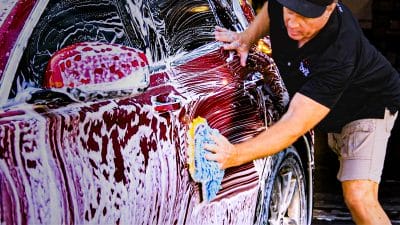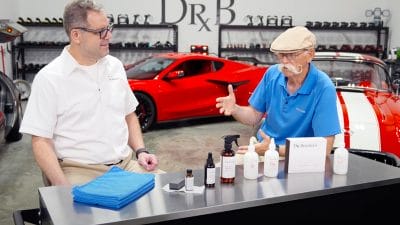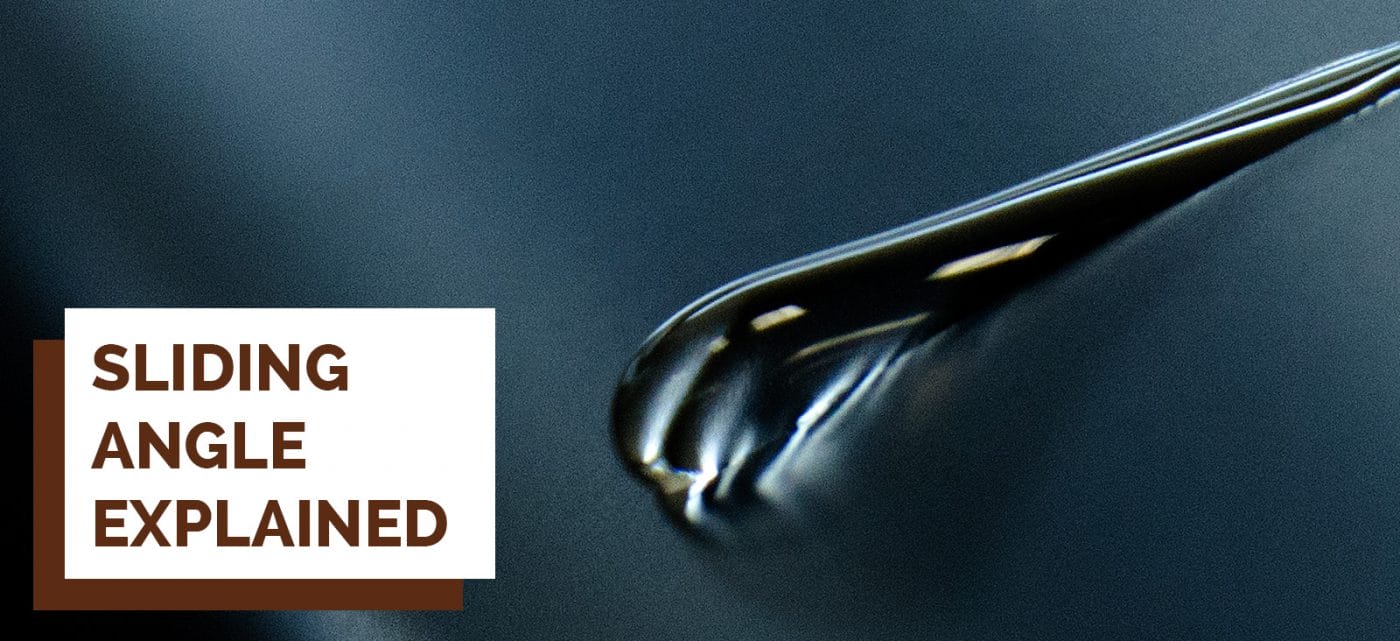Last Updated April 29, 2022
When water comes into contact with a car treated with a hydrophobic ceramic coating, it forms into small orbs on the surface instead of pooling. If those beads remain on the surface, and no one is there to dry them off, they can quickly turn into water spots, or, if you’re dealing with acid rain, etch marks. Sounds pretty awful, right? That’s why our mantra is “Beads Are Bad”! If you want your coating in good condition, you never want to see them on your finish. You want them gone.
So what is that makes beads take a hike? Many say it’s all in the water contact angle. A primer for the uninitiated: Water contact angle refers to the angle at which a bead of water touches a surface. The higher the contact angle, the more spherical a water bead looks. This line of thought makes sense on its face; the contact angle measure is after all what separates hydrophilic (water attracting) surfaces from hydrophobic ones, so it would stand to reason the higher the contact angle, the more easily it would be repelled off of the surface.
Here’s the thing—numerous scientific studies have observed water beads with lower contact angles moving more easily than beads with higher contact angles. So clearly, it can’t be contact angle that determines ease of bead movement. But if that doesn’t allow for bead mobility, what does? It’s something related to contact angle, but not entirely dependent on it: Sliding angle.
Sliding angle
The sliding angle is the angle of inclination at which a water bead of a certain weight will begin to slide off of your car. The lower the angle, the more easily a bead will roll off. And as mentioned above, contact angle alone can’t tell you anything about how high or low a sliding angle is. So what can? Well, there are a lot of variables at play: weight of the droplet, width of the droplet, gravitational acceleration… and those are just a few. Keep that in mind for later.
Why it matters
As we said in the introduction, beads hanging around on your finish can do some damage to your coating. But when beads have a low sliding angle, they just roll off of your car before they can do any harm. With that in mind, sliding angle quickly becomes the most important thing about a coating’s hydrophobicity. But sliding angle becomes even more important when you consider the variables we mentioned earlier.
Sliding angle tends to go down the bigger and heavier a body of water is, thanks to the laws of gravity. That’s why you see rain rolling off your car easily in a downpour, or why water seems to blast off of your finish when you hit it with a pressure hose. It’s also why small beads, like those from a light rain or a nearby sprinkler, have the hardest time rolling off your finish—gravity’s just not on their side.
So if you don’t have a strong gravitational force behind a bead of water, how else can you lower its sliding angle? You need to carefully re-engineer the car’s clear coat, transforming its structure at a nanoscopic level. That way, you can artificially create a surface so slick that almost nothing, even a small bead, can stick. How do you do that? Well, you can either be a scientist with access to expensive nanoengineering equipment, or you can get a Dr. Beasley’s ceramic coating.
Coatings engineered for low sliding angle
Through years of careful research, Dr. Beasley’s has perfected a ceramic coating technology that transforms automotive clear coat in a way that minimizes sliding angle, even for the smallest of beads. This technology is present in all of our ceramic coatings: just take Nano-Resin for example.
As you’d expect with most coatings, Nano-Resin excels at shedding large bodies of water, like blasts from a pressure hose. But because it transforms clear coat to create a nanostructure engineered for low sliding angle, even small beads from mild rainfall or lawn sprinklers roll off effortlessly. That’s a huge deal when you know just how harmful stagnant beads are. Suddenly, water spots become much less of an issue.
Changing the conversation
Now that it’s clear water contact angle doesn’t have much to do with how well a ceramic coating repels water, there needs to be a major shift in how we talk about ceramic coatings. We need to start integrating sliding angle into the conversation, and place a greater emphasis on how well a coating sheds small beads of water instead of how spherical those beads are. The ceramic coating picture is only half there; we need to fill in the rest.






Very informative article, thanks for the great read!
I believe the large “disconnect” between what we should aim for in coatings and what is typically hyped in industry is those super awesome water beading photos/videos all over social media. The bigger the beads, the better the coating, right?!!
I intend to apply Nano-Resin on my own vehicle to see these sliding angles performing first hand. All of the coatings I use for my business are aimed towards beading behaviors rather than sheeting, so I’m looking forward to experiencing the difference.
V/r
Carlos
SV Details
That sounds odd that the lower a sliding angle, the faster it falls off. You would think a high sliding angle would also determine how well it goes off the surface. If your sliding angle is 0, wouldn’t that mean that the water just sits there and pools?
Thank you
Great question! Sliding angle refers to the angle of inclination at which a bead will freely slide off of a surface. If a bead has a low sliding angle, that means it slides off more easily, because it doesn’t require a high angle of inclination to slide off. So if a bead had a sliding angle of 0 like you posited, it would slide off without any angle of inclination whatsoever.